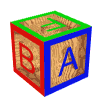|
Math concepts taught:
Sort and classify
Patterns and movement
Matching and counting
Count, identify and build number 0--30
Solid figures (sphere, cone, cylinder and cube)
Money (penny, nickel, dime and quarter)
Measurement (length, height, weight and capacity)
Time (sequencing, seasons, time to the hour and parts of a calendar)
Addition to 10
Subtraction from 10
Science concepts taught:
Living systems (introduction to plants and animals as living organisms)
Ecology (identify basic needs of organisms, food, water, air and shelter)
Matter and energy (sort objects according to physical properties)
Force, motion and mechanical energy (recognize an objects position relative to another)
Characteristics of the universe (seasonal effects of weather changes on human and animal activity. Identify objects
in the sky that move.)
Earth systems (describe the daily weather)
Social Studies concepts taught:
Constitutional Democracy (rules, laws, U.S. Flag, Pledge of Allegiance)
U.S. History (historical figures, exploration, settlement, colonization)
Governance Systems (decision making, resolving disputes peacefully, meaning of rule making, enforcing rules)
Economics (scarcity, opportunity cost, occupational opportunities)
Geographic study and analysis (maps, globes, places)
Relationship of individual and groups to institutions and traditions (common physical, social and emotional needs,
significant holidays)
Social Science inquiry (graphic and auditory aides, primary and secondary sources, library and media sources, artifacts)
Communication
Arts concepts taught using the Balanced Literacy approach: |

